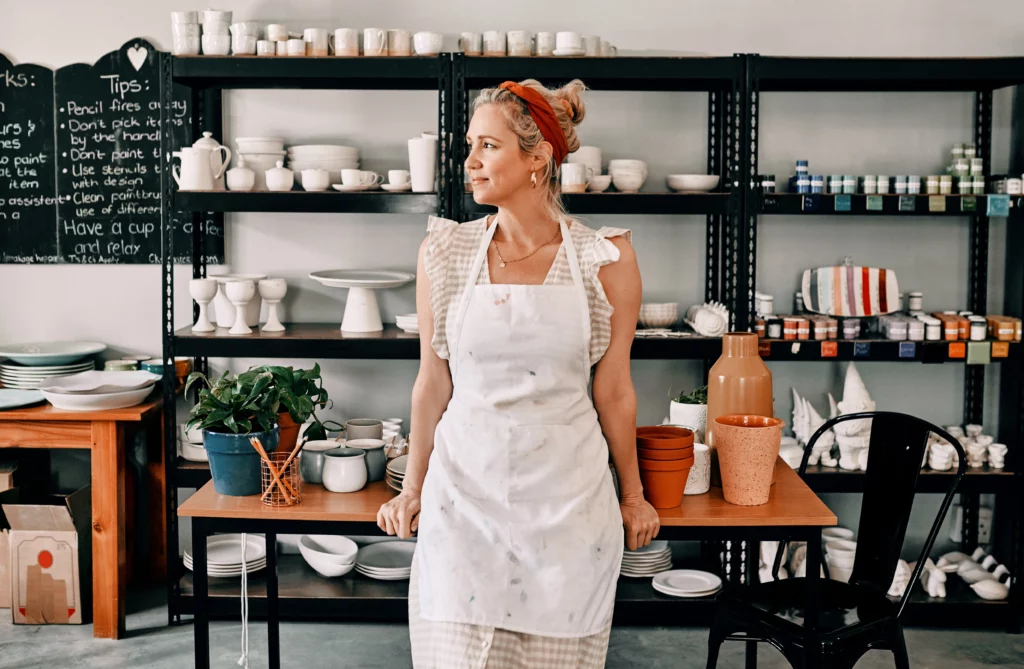Looking to turn your passion into a profit? Side hustle or full-time venture, crafting a solid business plan brings your artistic vision to life. Think of it like prepping a canvas; the gesso seals your idea in place, giving your art a stable foundation that’s made to last.
Feeling overwhelmed or unsure where to begin? Here’s a breakdown of what a business plan for small creative businesses looks like. Learn how to research your market, plan your finances, and find the right craft business insurance tailored to your needs.
Download Your Free Arts & Crafts Business Plan Template
Most artists are visual learners. That’s why we’ve designed this free arts and crafts business plan template to help guide your creative business planning. Download a copy and jot down your ideas as you follow along.
Crafting Your Art/Craft Business Plan: A Step-by-Step Guide
Some artists and crafters love to plan, plot, and picture every aspect of their work. If you’d rather go with your creative gut, you still need a business plan to keep you on track, clarify your goals, and avoid risks.
A business plan for artists takes the guesswork out of decision-making and ensures your dream has real value. Since most industry plans don’t cater to a craft business’s unique needs, we’ve outlined eight steps to help you build a solid foundation, so you can get back to making beautiful creations.

Step 1: Develop Your Mission and Vision Statements
Every company, big or small, should have a mission statement. This first step drives your business plan and ensures your decisions align with a common purpose. Why does your product exist, and what value does it bring?
Your vision statement is the sticky note on your bedroom mirror saying, “Go get ‘em!” It highlights your long-term goals for yourself and the business, whether that means brand recognition or opening a local boutique.
Here’s an example of each:
- Mission Statement: To create and sell handcrafted, minimalist jewelry using sustainable materials, empowering customers to express their style with pieces that are both beautiful and kind to the planet.
- Vision Statement: Become an activist and leader in the sustainable jewelry space, inspiring others to embrace ethically sourced materials and mindful creation.
Step 2: Showcase Your Products and Services
Listing out the crafts you make and services you provide consolidates them so you can change or grow your collection. Be as detailed as you like with photos or descriptions, and think about which crafts are easiest to make versus what takes more time.

What Makes Your Products Unique
Every business plan needs a Unique Value Proposition, or UVP. For artists and crafters, this defines what sets your craft apart from others and what value it brings to your audience.
Your UVP statement should reflect how your product solves your audience’s needs, problems, or preferences. This makes it easier to determine your potential in the market. Some UVP types include:
- Pricing: Position your product or service within your audience’s budget
- Brand story: Share your story and connect with customers on an emotional level
- Customization: Provide a personalized, one-of-a-kind experience
- Social impact: Appeal to customers who value ethical and sustainable practices
- Expertise: Build trust by highlighting how well you know your craft
- Style: Define your work’s unique, visual aesthetic
- Subject matter: Target an underserved market with niche interests
Unique Value Proposition Examples
🧶 Fiber artist: I hand-weave vibrant cultural murals that celebrate the richness of tradition, bringing a powerful sense of pride and history to your space.
💍 Handmade jeweler: I make one-of-a-kind jewelry from ethically sourced, natural materials, turning the raw beauty of the earth into wearable art.
🖼️ Portrait artist: I create custom, heartfelt pet portraits that celebrate the unique personality of your furry family member, giving you a cherished piece of art.
Pricing Strategy
Pricing out your production costs, like materials, labor, and overhead determines how much it costs to make each craft, so you can find a profitable price. Research different pricing strategies and formulas online, and be sure to include the following:
- Cost of materials: List the supplies required for each craft and how much they cost. If you buy materials in bulk, figure out how much they cost per craft.
- Labor: Pay yourself fairly for your time. Many artists and crafters pay themselves around $20 an hour.
- Overhead: This includes tools, equipment, seller fees, and anything else you need to make your products. Divide this number by the number of crafts you plan to sell per year.
Sourcing Materials
List the materials you need, how many, what they cost, and where you plan to buy them. This includes the materials to make your crafts, as well as any packaging or marketing materials.
Buying in bulk from arts and crafts stores or warehouses can save money in the long run. Keep a detailed inventory so you know when to order more or whether you’re overspending on a craft you rarely sell.
Step 3: Conduct Market Research & Analysis
Do you love attending craft shows and art exhibits? Have you already talked to several vendors about their work? Then you’re already researching the market!
Performing market research is vital to a successful craft venture. Your research helps you learn what makes you stand out, who your customers are, and how to market and sell your art.
- Identify your target customer. Understand how to reach your customers by considering factors like age, budget, hobbies, values, and shopping preferences
- Evaluate your competitors. Find your competitive advantage by comparing the strengths and weaknesses of competitors
- Look at industry trends. Identifying trends and learning how to adapt your business benefits you long-term. If more artists are offering custom services, you might want to, as well.
SWOT Analysis
A SWOT analysis involves critiquing your work while seeing what’s happening in the art world around you. How can you ensure that your business continues to thrive in a changing market?
- Strengths: What sets you apart from other people in your craft? Consider what special skills you have, your location, and how well you fit your particular niche.
- Weaknesses: Where do you have room for improvement? Perhaps your social media feed needs more content, or you have limited time.
- Opportunities: Outside factors that help your business grow might include an upcoming event, like a craft con or applying for a grant to help fund your art
- Threats: From economic issues to potential lawsuits and liability claims, think about how you can mitigate threats to your business, like having artist’s liability insurance or craft liability insurance
Your art deserves to take risks. Your livelihood doesn’t have to. Learn how to protect your business from the unexpected with this Free Risk Assessment Checklist for Artists & Crafters.

Step 4: Decide on Your Business Structure
Your business structure defines how your business is legally organized. It also affects your taxes, licensing requirements, and liabilities. Most artists start their businesses as sole proprietors, meaning you are the only employee.
A sole proprietorship gets your foot in the door so you can start selling, but it also means you’re responsible when things go wrong. Business liability insurance is your safety net for financial or legal risks.
For more information on structuring a creative business, check out our step-by-step guide to starting a handmade business.
Business Organization
Owning and operating a small business can be a lot of work. Enlisting help from family or hiring employees helps you delegate responsibilities to lighten your mental and physical load, so you can focus on crafting.
Make a list of all personnel related to your operations, including yourself, employees, a personal assistant, an accountant, or advisors. Describe their roles and include their contact information.
Step 5: Financial Projections
You’d rather crochet than crunch numbers, but finances are a major part of owning a business. A strong financial forecast ensures you’re on the right track, proves your business is viable, and helps you avoid common money mistakes. It can also help you secure funding in the future.
Financial Information for a Creative Business Plan
- Expense budget: This budget focuses on what it costs to run your business
- Sales projections: For a startup creative business, predict your monthly sales using your market research on industry trends and the population of target customers
- Cash flow statement: Using your sales projections, figure out how much money goes into and out of your business over 12 months
- Profit and loss statement: This summarizes your revenue, expenses, and profits/losses over time to show the strength of your profitability
- Break-even analysis: Your break-even point is the moment when your business earns a profit, or your sales exceed your expenses
Swimming in spreadsheets may not be your thing. Consider using online resources and free templates like Smartsheet to help guide you. You can also automate processes using budgeting apps that connect to your business bank account, making tracking your income and expenses easy.

Step 6: Create Your Marketing Strategy
Think back to your market research and where your target customers like to shop. Do they attend large festivals, or do they buy niche products online? More than just sales, consider how you want to promote your art, as well.
Common marketing strategies for artists and crafters include:
- Online: Build a website, sell on apps like Etsy, and use social media to promote your work
- Audience engagement: Earn customer loyalty and increase reach by responding to comments, asking for feedback, and sharing user content
- Craft shows & events: Sign up to be a vendor at arts and crafts events where you can meet customers face-to-face
- Art galleries: Professional artists showcase their work in galleries to gain visibility and credibility
- Email marketing: Reach out to customers directly and gain brand loyalty over time
Step 7: Set Business Goals
Your unique talent lies in your ability to take what’s in your mind and make it real. That’s what business goals are. They’re the vision that guides, motivates, and inspires you; the visible evidence that you’re making a difference with your art.
Your goals should align with your brand’s core values. Reread your mission and vision statements and think of how you can support them. Then, break your ideas down into short-term and long-term goals, making them realistic, measurable, and time-bound.
Here are a few examples of creative business goals:
🛍️ Launch an Etsy shop by the end of the first quarter
📲 Grow your social media following by 200 followers within the first six months
🎪 Attend five local craft shows over the summer, making up at least 15% in annual sales
💰 Reinvest 10% of monthly profits into new tools, equipment, or inventory
🎨 Streamline your creative process for best-selling items by making step-by-step guides within three months
Your goals don’t have to be perfect. Take it one step at a time, and if you oversucceed, great! If you don’t reach your goal, allow yourself an extension and keep going.
Step 8: Create an Executive Summary
Much like a brochure for an art exhibit, your executive summary offers a peek into your business, products, and potential for success. Written last but placed on the first page, it’s designed to intrigue future investors, lenders, or business partners.
A craft business executive summary includes:
- Who you are and your related experience
- The unique products or services you offer
- Where you plan to sell your products
- Growth expectations for your market
- Potential revenue projections
Why Business Insurance is a Must for Your Craft Venture
Feel like your startup is too small for insurance? Whether a piece of your gallery work causes damage or a customer trips and falls at your booth, one accident could put your business at risk.
ACT gives artists and crafters the peace of mind they need to run their business with customizable coverage that’s easy, affordable, and instant. With monthly and annual plans available, compare policies to find the right insurance for your needs.
Ready to protect your art and grow your business? Creative professionals with an ACT policy get access to our newsletter with more business tips and helpful resources!
FAQs About Business Plans for Artists and Crafters
What are the key components of an artist’s business plan?
The key components of a business plan for artists include:
- Mission and vision statements
- Overview of products and services, including pricing strategies
- Market research, including a SWOT analysis
- Business structure and organization
- Financial projections
- Marketing strategies
- Business goals and objectives
- Executive summary
Do I need a business plan if I am just starting as a crafter or artist?
Yes. Having a business plan when you’re just starting out provides the clarity you need to make important decisions, even if it’s a rough outline of your mission, products, goals, and market research.
How do I find my target market for my art business?
Finding your target market for your art business involves researching your audience and similar artists. You can do this by:
- Identifying similar artists and researching their customer base
- Using social media insights to find demographic information
- Attending local art markets to see who shops and sells at those events
- Exploring online communities or marketplaces and reading customer reviews
What financial information should be included in my business plan?
Your creative business plan should have the following financial information:
- Expense budget
- Sales projections
- Cash flow statement
- Profit and loss statement
- Break-even analysis
For a startup that has little to no sales, do your best to make monthly predictions. Focus on the costs of running your business and how many pieces of art or crafts you need to sell to start making a profit.
How can a business plan help me scale my craft business?
A creative business plan helps you scale your arts/crafts business with actionable growth strategies. Use it to clarify your goals, identify potential opportunities or risks, and plan your finances.


